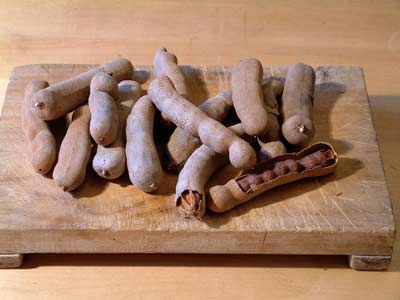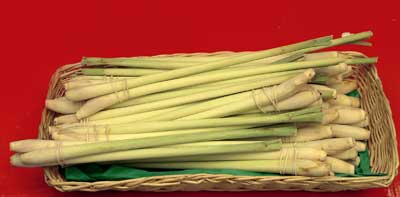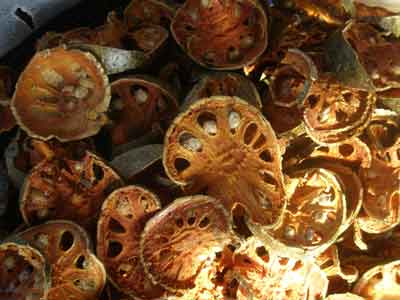
Tamarind. A sour-sweet fruit, sometimes known as the Indian date, used as a souring agent. It comes in long, dry brown pods which look almost like dried broad bean pods. Inside is a long, segmented fruit, like a long brown caterpillar. Each segment contains a hard, shiny black seed. As the pods dry the fruit becomes sweeter. A visitor from Mauritius suggested shaking the tamarind and, if you could hear that the fruit had detached and was rattling a little inside the pod, you would find that the fruit was sweet. All you need to do is to remove the pod and then chew the fruit, discarding the seeds. It is also available mashed and formed into a pulpy block or as a juice. In this form it is used like lemon juice.

Tamarind. A sour-sweet fruit, sometimes known as the Indian date, used as a souring agent. It comes in long, dry brown pods which look almost like dried broad bean pods. Inside is a long, segmented fruit, like a long brown caterpillar. Each segment contains a hard, shiny black seed. As the pods dry the fruit becomes sweeter. A visitor from Mauritius suggested shaking the tamarind and, if you could hear that the fruit had detached and was rattling a little inside the pod, you would find that the fruit was sweet. All you need to do is to remove the pod and then chew the fruit, discarding the seeds. It is also available mashed and formed into a pulpy block or as a juice. In this form it is used like lemon juice.
Paddy eel or swamp eel. I saw these for sale in the market in Luang Prabang but the woman who was selling them looked unhappy that I wanted to take a photograph, so I refrained.

Lemon grass is a herb used widely in the cooking of South East Asia. It is found in the form of a tightly encased grass which may be quite tough. The toughest outer leaves should be peeled away and then the white part chopped into thin slices and added to dishes.

Bael fruit; a close relative of the citrus. The fruit is about the size of, and has the appearance of a greyish-yellow orange with a thin woody rind. The floury pulp is pale orange in colour and has numerous seeds. Dried slices are soaked and boiled and the resulting liquid sweetened and drunk. Used for medicinal purposes.
When paddy rats are caught, they are often eviscerated, the intestines, livers and heads cleaned and packed into salt, in which form they may be sold in ethnic Chinese communities as gai cay, or "mock dog".
A pungent, dark, salty paste of shrimps or prawns which are salted, fermented in the sun and subsequently mashed and then dried in the sun. It is then sold in small blocks and is ubiquitous in the cooking of south east Asia. Local names throughout south east Asia and India have small variations in spelling, so it may be found masquerading as balacan, balachan, balachon, balachaun, balachaung, belacan, blacan, blachan, blachon, blachaun, blachaung, blakhan, and so on. On the other hand, it is also known independently as kapi, nga-pi, terasi and trasi. There are many other names for this extremely popular condiment, which lends a much more attractive flavour to dishes than would be imagined.